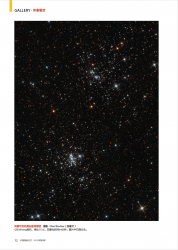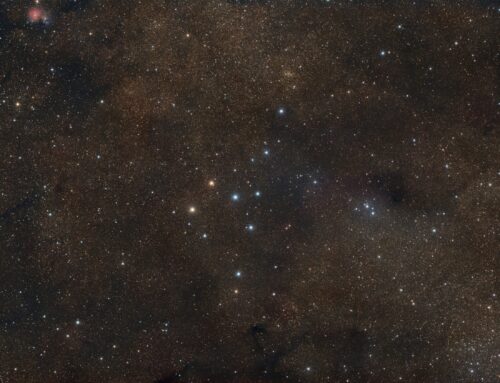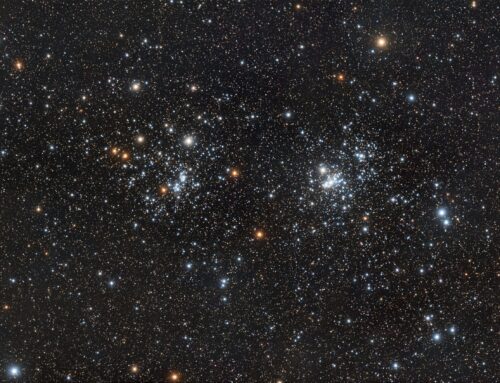The Double Cluster (2015)
Click image for full size version
May 10, 2015, published in Chinese National Astronomy Magazine, Sept. 2015
 There are two reasons for me posting this image of the Double Cluster from 2011 now: First, all of the objects I’ve imaged lately have been rather bland visually: faint galaxy clusters and sparse globulars. I thought it was time for some eye candy, and there is nothing tentative about the Double Cluster. Second, I’m working on a few new processing techniques and needed a subject with lots of background and lots of stars; this image made the perfect subject. Finally, I haven’t posted it before even though I did process it in 2011. The 2011 version is a little too dark for my taste and shows fewer stars than the current image.
There are two reasons for me posting this image of the Double Cluster from 2011 now: First, all of the objects I’ve imaged lately have been rather bland visually: faint galaxy clusters and sparse globulars. I thought it was time for some eye candy, and there is nothing tentative about the Double Cluster. Second, I’m working on a few new processing techniques and needed a subject with lots of background and lots of stars; this image made the perfect subject. Finally, I haven’t posted it before even though I did process it in 2011. The 2011 version is a little too dark for my taste and shows fewer stars than the current image.
The Double Cluster includes NGC869 (right) and NGC884, (known as h- and Chi-Pereus, respectively), each showing hundreds of stars. These clusters were bright enough to get star designations, and are both visible to the naked eye as foggy patches in a dark sky not far below the “left” side of the “W” of Cassiopeia in an autumn sky. In binoculars this pair looks like salt sprinkled in two little piles on a black tablecloth. In a small telescope the view is wonderful. Large telescopes reveal more stars, but tend to have too small a field to show the whole thing at once.
Both cluster are about 13 million years old (compared to 75-150 million years for the Pleaiades). They lie about 7500 light years away and a few hundred light years apart, and have a combined mass of about 6500 times the mass of our Sun. However, the clusters have a halo totalling more than 20,000 solar masses. Each cluster contains more than 300 blue giant stars. Furthermore, the colour of the clusters is shifted towards the blue because they are moving towards us at a speed of about 40 km/s.
The colour that is so evident in the stars in this shot is not very obvious to my eye in binoculars, but I can see some red in the stars with a small refractor. In 2011 we looked at this through Gord Rife’s then-newly silvered (with real silver!) mirror at fairly high power, and star colours were in-your-face, with subtle differences being visible. Aluminum-coated mirrors are more durable, but they sure don’t show the colours the way silver does.
Tekkies
QSI583wsg camera, Astrodon LRGB Gen-2 filters, 10″ f/6.8 ASA astrograph, MI-250 mount, SX Lodestar camera for guiding through the QSI guide port. Acquired from my SkyShed in Guelph. Gibbous moon, no cloud, average transparency and average seeing. MaximDL was used for acquisition, guiding and calibration. PixInsight was used for all pre-processing and processing.
7x2m L, 4x5m R, 3x5m G and 3x5m B unbinned frames (total=1hr 4m). Yes, really, just over an hour!
RGB:
Creation and cleanup: R, G and B masters were cropped and combined to make an RGB image which was processed with DBE and ColourCalibration.
Stretching: HistogramTransformation was applied to make a pleasing yet bright image.
Synthetic Luminance:
Creation and cleanup: The cropped R,G and B masters were combined using the ImageIntegration tool (average, additive with scaling, noise evaluation, iterative K-sigma / biweight midvariance, no pixel rejection). DBE was applied to neutralize the background.
Stretching: HistogramTransformation was applied to make a pleasing yet bright image.
Combining SynthL with RGB:
The luminance channel of the RGB was extracted, processed and then added back into the RGB image as follows:
1. Extract luminance from the RGB image.
2. Apply LinearFit using the SynthL channel as a reference.
3. Use ChannelCombination in Lab mode to replace the RGB’s luminance with the fitted luminance from step 2.
4. LRGBCombine was then used to make a SynthLRGB image.
Final Processing
TGVDenoise was applied to the SynthLRGB image in Lab mode followed by a histogram stretch to increase image contrast. A star core mask was made by applying morphological transformation and convolution to a copy of SynthL. Colour saturation in star cores was increased using this mask. The background was slightly smoothed using a Pixel Math expression to lighten the very darkest pixels as follows:
iif($T<0.03, ((med($T)-$T)/1.8)+$T,$T)
Thank you to Alejandro Tombolini for this idea.
Saturation and brightness were tweaked. Image scale for this telescope/camera combination is 1.23 arcsec/pixel.







Leave A Comment